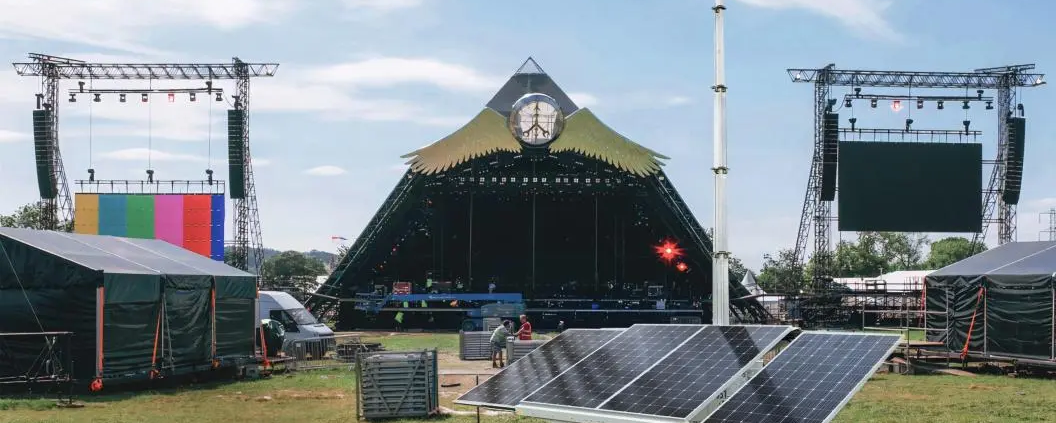How to Choose the LED Solar Lighting Tower with Hybrid Energy Options
Choosing the Right LED Solar Lighting Tower with Hybrid Energy Options
When selecting a solar lighting tower with mixed energy sources (solar, wind, diesel, grid), consider lighting requirements, range, functionality, runtime, and specific site conditions.
Quick comparison (three common models for initial screening)
- Small Solar Tower — Height: 6 m; Coverage: ~750 m²; Light output: ~33,000 lm; Battery pack: ~9.6 kWh; Run time: ~28.8 h (depends on brightness).
- Medium Mobile Lighting Trailer — Height: 9 m; Coverage: ~1,500 m²; Light output: ~66,000 lm; Battery pack: ~14.4 kWh; Run time: ~20 h.
- Large Portable Lighting Trailer — Height: 12 m; Coverage: ~2,200 m²; Light output: ~198,000 lm; Battery pack: ~28.8 kWh; Run time: ~20 h.
Note: Actual run times depend on brightness settings, load, weather, and site conditions. Use actual test data for precise planning.

2. Choose Based on Illumination Coverage
3. Choose Based on Functionality
- 4G Monitoring: Optional for real-time monitoring in populated areas, construction sites, and sensitive locations to enhance security and asset protection.
- Emergency Rescue Applications: Opt for models with hybrid charging and prioritize the highest-capacity unit to maximize runtime and brightness for disaster response.
- Battery Type: Lead-acid batteries are commonly chosen for safety on outdoor work sites where lithium poses fire risks in unstable environments; LiFePO4 options are also available with appropriate safety measures.
- 5G Base Station Capability: Useful for remote or weak-signal regions, extending connectivity where needed.
4. Brightness and Energy Efficiency
- Brightness levels typically come in three tiers:
- 33,000 lm — suitable for small sites and low-density work zones.
- 66,000 lm — suitable for mid-sized work zones and security needs.
- 198,000 lm — for high-security environments or large-scale operations requiring broad visibility.
- Usage guidance: For small sites, lower brightness is often sufficient; for larger sites or higher security, higher brightness is preferable.
- Energy efficiency: Prioritize luminaire efficiency above 150 lm/W to reduce long-term operating costs.
5. Color Temperature and Rendering
- Color temperature choices: 5000–6500 K (cool white) for work areas and emergency operations; 2700–3000 K (warm white) for rest or safe zones where comfort matters.
- Color rendering (CRI): Higher CRI (>80) helps distinguish colors and details in critical environments such as emergency response, mining, construction, camping, safety checkpoints, signal stations, and security zones.
- Efficiency: LED luminaires with high efficacy support energy savings over time.
For environmental friendliness and performance, consider hybrid-energy towers that automatically switch among solar, wind, diesel, and grid sources to maintain lighting in variable conditions.
Understanding Different Hybrid Energy Solar Lighting Towers
Solar-Only Lighting Tower
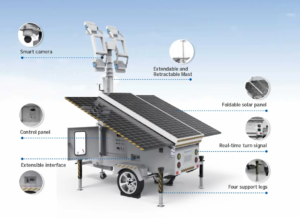
Advantages: Eco-friendly, low operating costs, simple maintenance.
- Features: 360° rotation and lighting
- Working Time: Up to 35 hours
Typical applications: Sunny regions, suitable for temporary or long-term lighting needs.
Representative models:
Solar Lighting Tower (Mobile),
Solar Lighting Tower (Variant 2).
Wind and Solar Hybrid Lighting Tower
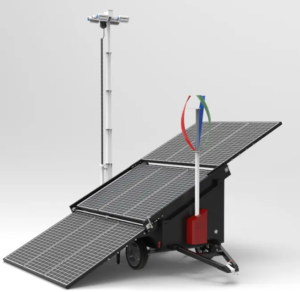
Advantages: Delivers stable power in wind-rich regions.
- Features: Up to 80 hours of working time
- Typical Applications: Remote Areas, Sites with Abundant Wind Resources, Emergency Lighting after Disasters
Representative models:
Sun-Wind Hybrid Solar Taiters and
Sunwind Mobile Solar Generator.
Diesel and Solar Hybrid Generator Tower
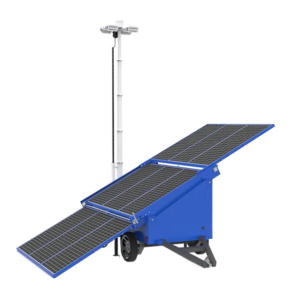
Advantages: Stable energy supply in areas without grid access.
- Features: Up to 80 hours of running time
- Typical Applications: Remote Construction, Mountain Rescue, Major Event Logistics Points
Representative model:
Sundiesel Hybrid Solar Tailers.
Grid-Powered Lighting Tower
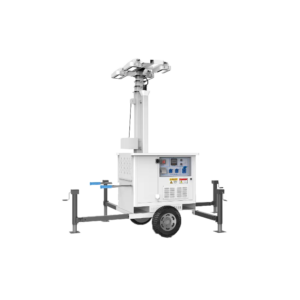
Advantages: Stable energy supply where electricity grids exist.
- Efficiency: 195 lm/W luminaire efficiency
- Illuminated Area: 1,200 m²
- Working Time: 35 hours
- Typical Applications: Large Construction Sites, Urban Infrastructure Locations, Event Venues
Representative model:
Electric Mobile Lighting Tower (T300, 6 m).
Quick Reference Selection Table
| Model | Height | Coverage Area | Light Output | Battery Capacity | Run Time (Typical) | Energy Options |
|---|---|---|---|---|---|---|
| Small Solar Tower | 6 m | 750 m² | 33,000 lm | 9.6 kWh | ~28.8 h | Solar, Hybrid, Diesel, Grid (Optional) |
| Medium Mobile Light Trailer | 9 m | 1,500 m² | 66,000 lm | 14.4 kWh | ~20 h | Solar, Hybrid, Diesel, Grid (Optional) |
| Large Portable Light Trailer | 12 m | 2,200 m² | 198,000 lm | 28.8 kWh | ~20 h | Solar, Hybrid, Diesel, Grid (Optional) |
Other Considerations
Maintenance and Servicing
- Regular inspection of luminaires and batteries
- Clean photovoltaic panels to maintain system performance
- Ensure overall system reliability through routine checks
Environmental Adaptability
- Protection Rating: Choose fixtures with high IP ratings (e.g., IP65) to withstand harsh weather conditions
Budget and Total Cost
- Consider upfront equipment costs, installation, and ongoing maintenance for a true total cost of ownership
Luxman portable solar lighting towers use high-efficiency solar panels, long-life lithium batteries, and high-brightness LED luminaires to ensure stable, long-term performance. Luxman also offers hybrid-energy models (e.g., solar+wind, solar+diesel) to meet diverse environments and requirements.
By following these guidelines, you can select the Luxman portable solar lighting tower that best fits your needs and ensure reliable illumination and long-term performance.
Ready to find the perfect model for your site? Contact Luxman today for a tailored solution.

